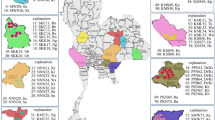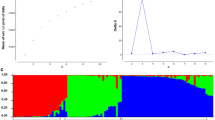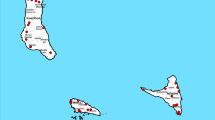Abstract
Knowledge of the origin, organization and nature of the cassava (Manihot esculenta Crantz) germplasm collection in Brazil is incomplete due to lack of critical information on several aspects of the collection. This study verifies the utility of SSR-primed PCR markers for germplasm assessment and then utilizes these markers as well as RAPD's to characterize the Brazilian collection. We specifically address the following questions: 1)what is the relationship of morphologically closely related species to cultivated cassava? 2) What is the genetic diversity of cultivars within and between different habitats in Brazil? 3) Do agronomic traits and molecular markers reveal the same relationship among cassava accessions? 4) How complete is the Brazilian cassava collection and how well is it represented in the Word Core Collection of cassava, maintained by CIAT? Results of the interspecific studies of cassava and its wild relatives confirms the close relationship of cassava, Manihot esculenta ssp. esculenta to Manihot esculenta ssp. flabellifolia as well identifying several other closely related wild species. Next, PCR-based markers indicate a strong grouping of varieties related to the region of cultivation in Brazil. Moreover, important regions such as Cerrados and Amazon are relatively poorly represented in germplasm collections. Interestingly, the relationships of accessions based on agronomic traits are not fully congruent with relationships revealed with RAPD markers. Finally, the genetic diversity of the Brazilian cassava collection is not fully represented in the Core of the Word Core Collection of CIAT.
Similar content being viewed by others
References
Allem, A.C., A.C. Roa, R.A. Mendes, A.N. Salomao, M.L. Burle, G. Second, P.C.L. Carvalho & Cavalcanti, 2000. The primary gene pool of cassava (Manihot esculenta Crantz). In: L.J.C.B. Carvalho, A.M. Thro & A.D. Vilarinhos (Eds.), Cassava Biotechnology - IV Intl Sci Meet-CBN, EMBRAPA-Genet Res Biotechn, Brasilia-DF, Brazil, pp. 3–14.
Allem, A.C., 1994. The origin of Manihot esculenta Crantz (Euphorbiaceae). Genet ResCrop Evol 41: 133–150.
Beeching, J.R., P. Marmey, M.C. Cavalda, M. Noirot, H.R. Hayson, M.A. Hughes & A. Charrier, 1993. An assessment of genetic diversity within a collection of cassava (Manihot esculenta Crantz) germplasm using molecular markers. Ann Bot 72: 515–520.
Bertram, R.B., 1993. Application of molecular techniques togenetic resources of cassava (Manihot esculenta Crantz. Euphorbiaceae): Inter specific evolutionary relationships and infra specific characterization. Ph.D. dissertation. University of Maryland, USA. 465 pp.
Cabral, G.B., L.J.C.B. Carvalho & B.A. Schaal, 2000. Relationship analysis of closely related species to cassava (Manihot esculenta Crantz) based on microsatellite-primed PCR. In: L.J.C.B. Carvalho, A.M. Thro & A.D. Vilarinhos (Eds.), Cassava Biotechnology - IV Intl Sci Meet-CBN, EMBRAPA-Genet Res Biotechn, Brasilia-DF, Brazil, pp. 36–50.
Carvalho, L.J.C.B., B.A. Schaal & W.M.G. Fukuda. 2000a. Agronomic traits descriptors and Random Amplified Polymorphic DNA (RAPD) marker were used to assess the genetic diversity of cassava (Manihot esculenta Crantz). In: L.J.C.B. Carvalho, A.M. Thro & A.D. Vilarinhos (Eds.), Cassava Biotechnology - IV Int Sci Meet-CBN, EMBRAPA-Genet Res Biotechn, Brasilia-DF, Brazil, pp. 51–64.
Carvalho, L.J.C.B., B.A. Schaal & W.M.G. Fukuda, 2000b. Genetic diversity ofcassava (Manihot esculenta Crantz) in a germplasm collection assessed by RAPD markers. In: L.J.C.B. Carvalho, A.M. Thro & A.D. Vilarinhos (Eds.), Cassava Biotechnology - IV Intl Sci Meet-CBN, EMBRAPA-Genet Res Biotechn, Brasilia-DF, Brazil, pp. 80–92.
Clark, A.G. & C.M.S. Lanigan, 1993. Prospects for estimating nucleotide divergencewith RAPDs. Molec Biol Evol 10: 1096–1111.
Fukuda, W.M.G. & A.A.C. Alves, 1987. Bancoativo de germoplasma de mandioca do Centro Nacional de Mandioca e Fruticultura. Rev Bras Mandioca 6: 5–97.
Gillings, M. & M. Holley, 1997. Amplification of anonymous DNA fragments using pairs of long primers generatesreproducible DNA fingerprints that are sensitive to genetic variation. Electrophoresis 18: 1512–1518.
Gillings, M. & M. Holley, 1997. Amplification of anonymous DNA fragments using pairs of long primers generates reproducible DNA fingerprints that are sensitive to genetic variation. Electrophoresis 18: 1512–1518.
Gupta, P.K. & R.K. Varshney, 2000. The development and use of microsatellite markers for genetic analyis and plant breeding with emphasis on bread wheat. Euphytica 113: 163–185.
Huff, D.R., R. Peakall, P.E. Smouse, 1993. RAPDvariation within and among natural populations of outcrossing buffalo grass [Buchloe dactyloides (Nutt) Engelm]. Theor Appl Genet 86: 927–934.
Kawano, K., A. Amaya, P. Daza & M. Rios, 1978. Factors affecting efficiency ofhybridization and selection in cassava. Crop Sci 18: 373–380.
Kresovich, S., J.G.K. Williams, J.R. McFerson, E.J. Routman & B.A. Schaal, 1992. Characterization of genetic identifies and relationships of Brassica oleracea L. via random amplified polymorphic DNA assays. Theor Appl Genet 85: 190–196.
Lefevre, F., 1989. RessourcesGénétiques et amelioration du Manihoc, Manihot esculenta Crantz, en Afrique. Doctoeur These. Institut National Agronomique Paris-Grignon. ORSTOM - Institut Français de Recherche Scientifique pour le Developpment en Cooperation. Paris, France, 176 pp.
Lennis, J., A. Alvarado & R. Vera, 1991. Classificacion Morfologica de 23 cultivars de Manihot esculentaCrantz del subtropic humedo Boliviano. Turrialba 41: 258–265.
Marmey, P., J. Beeching, S. Hamon & A. Charrier, 1994. Evaluation of cassava (Manihot esculenta Crantz) germplasm collections using RAPD markers. Euphytica 74: 203–209.
Olsen, K.M., 2000. Evolution in a Recently Arisen Species Complex:Phylogeography of Manihot esculenta Crantz (Euphorbiaceae). PhD dissertation. Department of Biology-Washington University. 261 pp.
Olsen, K.M. & B.A. Schaal, 1999. Evidence on the origin of cassava: Phylogeography of Manihot esculenta.PNAS 96: 5586–5591.
Pereira, A.V., 1989. Divergencia genetica em mandioca (Manihot esculenta Crantz).Tese de doutorado. ESALQ. Piracicaba-SP. 176 pp.
Roa, A.C., M.M. Maya, M.C. Duque, J. Tohme, A.C. Allem & M.W. Bonierbale, 1997. AFLP analysis of relationships among cassava and other Manihot species. Theor Appl Genet 95: 741–750.
Rogers, D.J., 1965. Some botanical and ethnological considerations of Manihot esculenta. EconBot 19: 369–377.
Rogers, D.J. & S.G. Appan, 1973. Manihot - Manihotoides (Euphorbiaceae). FloraNeotropica. Monograph 13. Hafner Press. New York, 272 pp.
Rohlf, F.J., 1993. NTSYS-pc. NumericalTaxonomy and Multivariate Analysis System: Version 1.60. Applied Biostatistics, New York.
Stiles, J.I., C. Lemme, S. Soundur, M.B. Morshidi & R. Manshardt, 1993. Using randomly amplified polymorphic DNA for evaluating genetic relationships among papaya cultivars. Theor Appl Genet 85: 697–701.
Zietkiewicz, E., A. Rafalski & D. Labuda, 1994. Genome fingerprinting by simple sequence repeat (SSR) - anchored polymerase chain reaction amplification. Genomics 20: 176–183.
Author information
Authors and Affiliations
Rights and permissions
About this article
Cite this article
Carvalho, L.J.C.B., Schaal, B.A. Assessing genetic diversity in the cassava (Manihot esculenta Crantz) germplasm collection in Brazil using PCR-based markers. Euphytica 120, 133–142 (2001). https://doi.org/10.1023/A:1017548930235
Issue Date:
DOI: https://doi.org/10.1023/A:1017548930235




